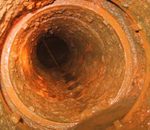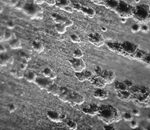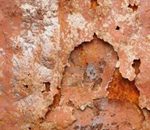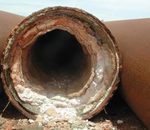Sanitization
 Membrane biofouling is defined as the adherence and growth of algae and bacteria on a membrane surface. The process of biofouling will affect the performance of a membrane system. First by the attachment and growth of microorganisms and algae on the feed spacer which will lead to an increased resistance over the feed channel. Second, by covering the membrane surface with a layer of biomass and blocking the feed water from the area where ROor nanofiltration can take place. As consequence, more feed pressure (i.e more energy ) is needed for the same mass flow of produced water.
Membrane biofouling is defined as the adherence and growth of algae and bacteria on a membrane surface. The process of biofouling will affect the performance of a membrane system. First by the attachment and growth of microorganisms and algae on the feed spacer which will lead to an increased resistance over the feed channel. Second, by covering the membrane surface with a layer of biomass and blocking the feed water from the area where ROor nanofiltration can take place. As consequence, more feed pressure (i.e more energy ) is needed for the same mass flow of produced water.
Steam Condensate Treatment
 Corrosion can threaten the reliability and safety of critical steam equipment, frequently taking the form of acid or CO2 corrosion, dissolved oxygen attack, erosion or flow-assisted corrosion, and/or downtime/storage corrosion. If left untreated, ongoing corrosion can result in significantly higher maintenance and equipment replacement costs, reduced runtime, unscheduled outages, and lower product quality. Aquamine steam condensate treatment can help minimize corrosion throughout the condensate system and drive overall productivity with less maintenance, downtime, and asset maintenance and repair costs.
Corrosion can threaten the reliability and safety of critical steam equipment, frequently taking the form of acid or CO2 corrosion, dissolved oxygen attack, erosion or flow-assisted corrosion, and/or downtime/storage corrosion. If left untreated, ongoing corrosion can result in significantly higher maintenance and equipment replacement costs, reduced runtime, unscheduled outages, and lower product quality. Aquamine steam condensate treatment can help minimize corrosion throughout the condensate system and drive overall productivity with less maintenance, downtime, and asset maintenance and repair costs.
Internal Treatment
 Aquakem Treatment programs provide highly effective protection against scale formation and corrosion to improve the reliability and efficiency of your boiler system. Treatments include all-Polymer programs, as well as coordinated phosphate/pH, chelant, and phosphate programs to best fit your system.
Aquakem Treatment programs provide highly effective protection against scale formation and corrosion to improve the reliability and efficiency of your boiler system. Treatments include all-Polymer programs, as well as coordinated phosphate/pH, chelant, and phosphate programs to best fit your system.
Feedwater Pretreatment

Because of its highly localized nature, pitting attack caused by dissolved oxygen can result in rapid failure of feedwater lines, economizers, boiler tubes and condensate lines. AquaOX inorganic and organic oxygen scavenger formulations rapidly remove any dissolved oxygen remaining after mechanical de-aerating.
Treatment programs provide highly effective protection against scale formation and corrosion to improve the reliability and efficiency of your boiler system. Treatments include all-Polymer programs, as well as coordinated phosphate/pH, chelant, and phosphate programs to best fit your system.

Corrosion Control

Corrosion is caused by metals attempting to return to their natural state. Corrosion can be present in many forms, including uniform metal loss, localized or pitting, bi-metallic, galvanic, under deposit, and microbiological induced corrosion (MIC). The process starts when surface irregularities, stresses, or compositional differences result in the formation of a corrosion cell. Once started, corrosion at the anode causes metal to be released into the system or redeposit locally. Pitting is particularly problematic because the local loss of metal can result in thru-wall perforation of piping and tubing

Scale/Deposit Control

Cooling water systems are subject to a variety of contaminants that can interfere with heat transfer, increase corrosion rates, restrict water flow, and cause loss of process efficiency and production. Customized scale inhibitor programs are necessary for mineral scale and sludge prevention. Mineral Scales
Calcium carbonate, calcium sulfate, calcium phosphate, magnesium silicate, silica compounds, and mixtures of these Sludge and Organics Silt and windblown debris, biological deposits, metallic oxides, corrosion products, oil.

Biological Control

Cooling water towers can be ideal breeding grounds for biological growth, including algae, bacteria, sulfate-reducing bacteria, protozoa, and fungi. If not properly controlled, these organisms will form a layer of bio-slime that acts as a natural adhesion surface for scale formation, resulting in increased corrosion rates, restricted water flow, and reduced system efficiency

